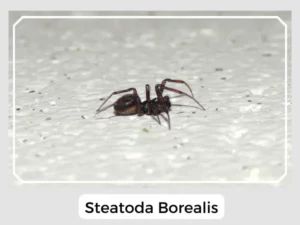Guess what? There’s a spider called Steatoda borealis, and it’s part of the comb-footed spider family. Some people call it a ‘false widow spider’ because of how it looks. But it’s not the same as the real widow spiders. Keep reading, and we’ll tell you more about this interesting creature!

Photo Credit: Scotty Astro
Like other false widow species, they lay their eggs inside a white sac.
They are red in color and disperse soon after leaving the egg sac.
The web of these spiders is made up of cobwebs consisting of irregular tangles of sticky silken fibers.
Yes, Steatoda borealis Spiders are venomous. Their venom helps them catch and eat tiny bugs, but it’s not very strong for humans.
Yes, Steatoda borealis Spiders can bite. They’re usually quiet spiders, but if they do bite, it feels a bit like a small pinch and may cause some pain and redness. Their bite isn’t harmful to most people.
Steatoda borealis spiders are integral to their ecosystems as they help regulate insect populations. Their presence under bark, stones, and inside buildings indicates their adaptability and predatory efficiency. They also compete with other spiders for resources, including true black widows, demonstrating their robustness as a species.
Natural Predators: While they are predators themselves, Steatoda borealis spiders also fall prey to larger spiders, playing a role in the complex food web of their habitats.
Prey-Predator Dynamics: The interaction between Steatoda borealis and their prey highlights the balance of ecosystems. Their venom, although not significantly harmful to humans, is potent enough to subdue insects like crickets, cockroaches, and even other spiders, which they consume.
Relationship with Humans: Despite being venomous, bites from Steatoda borealis are rare and typically not serious, causing only minor discomfort. They are often found in less disturbed areas of buildings, indicating a coexistence with humans where they contribute to controlling pest populations.
| Lifespan | 1-3 years |
| Distribution | North America, primarily the northern United States and Canada |
| Habitat | Under bark and stones, in rock crevices, and inside some parts of buildings such as attics and basements. |
| Common Predators | Other spiders |
| Diet | Insects like crickets, cockroaches, ladybirds, woodlice, and spiders, including true black widows |
In summary, Steatoda borealis plays a significant role in controlling insect populations and providing a check on other spider species, including some that are venomous to humans.
Guess what? There’s a spider called Steatoda borealis, and it’s part of the comb-footed spider family. Some people call it a ‘false widow spider’ because of how it looks. But it’s not the same as the real widow spiders. Keep reading, and we’ll tell you more about this interesting creature!

Photo Credit: Scotty Astro
Like other false widow species, they lay their eggs inside a white sac.
They are red in color and disperse soon after leaving the egg sac.
The web of these spiders is made up of cobwebs consisting of irregular tangles of sticky silken fibers.
Yes, Steatoda borealis Spiders are venomous. Their venom helps them catch and eat tiny bugs, but it’s not very strong for humans.
Yes, Steatoda borealis Spiders can bite. They’re usually quiet spiders, but if they do bite, it feels a bit like a small pinch and may cause some pain and redness. Their bite isn’t harmful to most people.
Steatoda borealis spiders are integral to their ecosystems as they help regulate insect populations. Their presence under bark, stones, and inside buildings indicates their adaptability and predatory efficiency. They also compete with other spiders for resources, including true black widows, demonstrating their robustness as a species.
Natural Predators: While they are predators themselves, Steatoda borealis spiders also fall prey to larger spiders, playing a role in the complex food web of their habitats.
Prey-Predator Dynamics: The interaction between Steatoda borealis and their prey highlights the balance of ecosystems. Their venom, although not significantly harmful to humans, is potent enough to subdue insects like crickets, cockroaches, and even other spiders, which they consume.
Relationship with Humans: Despite being venomous, bites from Steatoda borealis are rare and typically not serious, causing only minor discomfort. They are often found in less disturbed areas of buildings, indicating a coexistence with humans where they contribute to controlling pest populations.
| Lifespan | 1-3 years |
| Distribution | North America, primarily the northern United States and Canada |
| Habitat | Under bark and stones, in rock crevices, and inside some parts of buildings such as attics and basements. |
| Common Predators | Other spiders |
| Diet | Insects like crickets, cockroaches, ladybirds, woodlice, and spiders, including true black widows |
In summary, Steatoda borealis plays a significant role in controlling insect populations and providing a check on other spider species, including some that are venomous to humans.